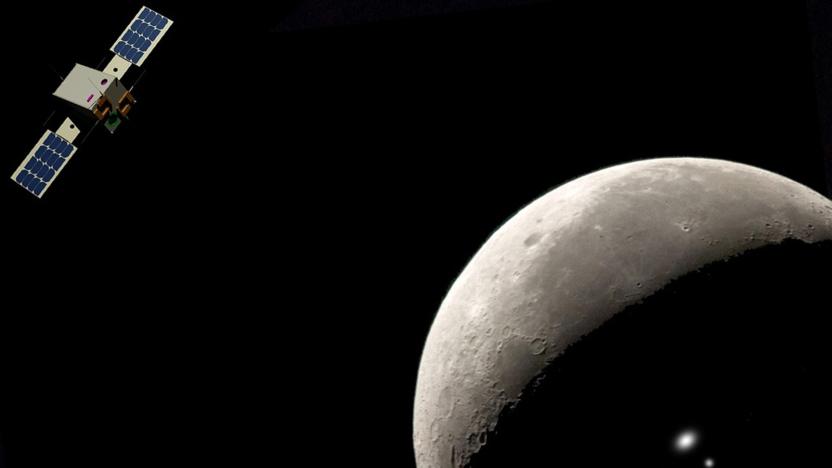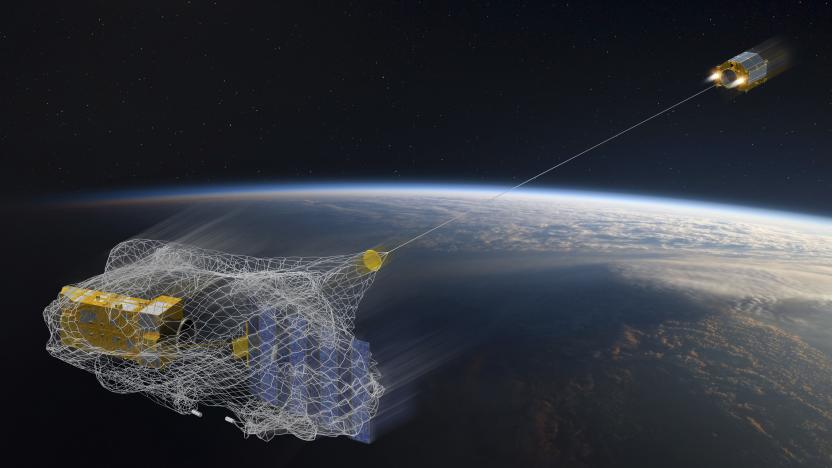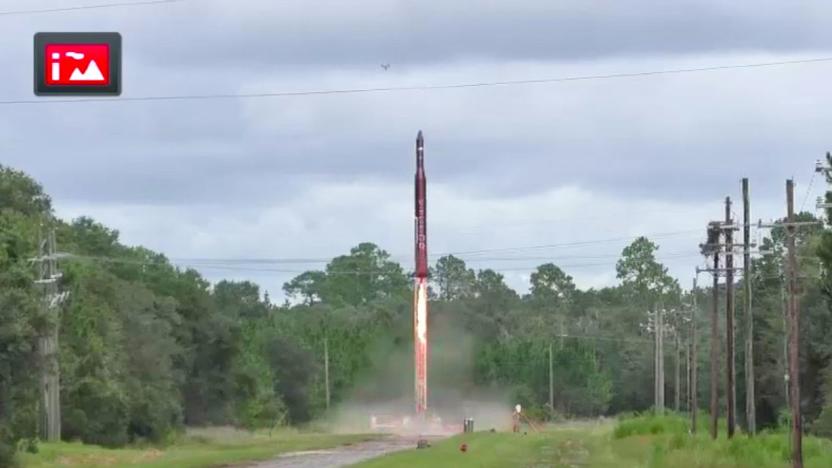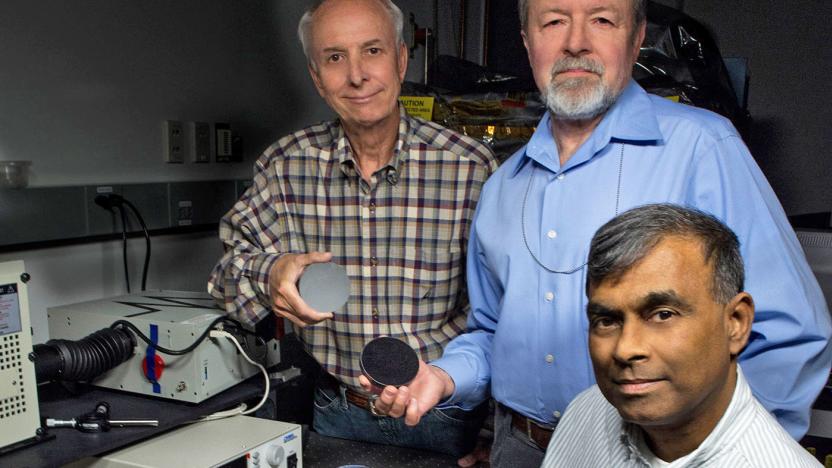Cubesat
Latest

Japan launches smallest rocket ever to carry satellite into orbit
Japan has set a new spaceflight record -- and unlike most of these feats, it's defined by what wasn't involved. The country's Aerospace Exploration Agency (JAXA) has successfully launched the smallest-ever rocket to carry a satellite into orbit, a modest SS-520 sounding rocket modified with a third stage inside its nose cone to get its payload into orbit. As you might guess, the key to the record was the tiny cargo -- the rocket was carrying TRICOM-1R, a three-unit cubesat measuring just 13.6 inches long. You don't need a giant vehicle when the mission hardware would fit in the backseat of your car.

ESA picks two tiny spacecraft to study the dark side of the Moon
Tiny cube spacecraft aren't just useful around Earth's orbit. The European Space Agency has chosen two winners in a competition to build cubesats that will study the dark side of the Moon. The first, the Lunar Meteoroid Impact Orbiter (Lumio), would circle around the Moon's far side to map meteor bombardments by looking for bright flashes. The Lunar Volatile and Minearology Mapping Orbiter (VMMO), meanwhile, would study the permanently darkened Shackleton Crater near the lunar south pole to look for water ice and other materials that could be useful for colonists. It would keep watch for radiation, too.

Mini-Hubble will scan dim stars to see if they can support life
It doesn't take hugely expensive space telescopes like the Hubble and future James Webb Space Telescope to hunt for habitable exoplanets. NASA and the University of Arizona will launch a small telescope the size of a cereal box called the Star-Planet Activity Research CubeSat, or SPARCS, in 2021. The aim is to find so-called M Dwarfs, stars 20 times dimmer than our sun, and see if they emit too much radiation to support life on other worlds.

The robots that will sweep Earth's skies
After six years in space, China's first orbital station, the Tiangong-1 (aka the "Heavenly Palace") has finally outlived its operational limits and begun its descent to Earth. It's expected to re-enter the atmosphere in a few months, whereupon a majority of the 9.3-ton station should burn up before reaching the surface. This is how defunct satellites are supposed to be disposed of. Unfortunately, until very recently, that hasn't often been the case.

Vector successfully launches prototype rocket for small satellites
Today, Vector, a company that aims to deliver small and nano-satellites into orbit, successfully launched a full-scale prototype of its Vector-R rocket. It was a suborbital flight; the rocket took off from a spaceport in Camden, GA. It's the first for Vector (and for the small-satellite launching industry) that is fully funded by customers and has their payloads on board.

Japan's experimental mini rocket launch ends in failure
Japan's space program troubles aren't over yet, apparently. The country's Aerospace Exploration Agency reports that the launch of its miniature SS-520 rocket ended in failure. The first stage went off without a hitch, but communications problems prevented the second stage from igniting and carrying a microsatellite, TRICOM 1, into orbit. While rocket failures certainly aren't unheard of (just ask SpaceX), the incident is a black eye given what Japan wanted to achieve.

NASA plans to launch swarms of small satellites to study Earth
NASA announced its plans to deploy multiple swarms of tiny weather-sensing, climate change-observing satellites over the next few months during a teleconference held on Monday. The satellites will not only help advance climate science but also enable them to build the next generation of "small-satellites" for far less than they do today.

White House initiative pushes for more tiny satellites
Miniature satellites are increasingly a big deal, and for good reasons: they're not only less expensive and easier to deploy than the giant satellites of old, but can cover wider areas. And the White House wants to give them a helping hand. It's launching an initiative that will foster small satellites with the resources they need to flourish. To start, NASA is not only proposing as much as $30 million toward purchasing data from these tiny vessels, but creating a Small Spacecraft Virtual Institute that will offer know-how to organizations. A more direct effort has the National Geospatial-Intelligence Agency awarding Planet a $20 million contract for a fleet of small satellites that can capture images of "at least" 85 percent of the planet every 15 days.

NASA is making a small carbon nanotube telescope for CubeSats
A team of NASA Goddard scientists are developing a lightweight and low-cost telescope small enough to fit inside CubeSats. Those mini satellites provide the agency an inexpensive means to send various experiments to outer space. By creating a small telescope sensitive to ultraviolet, visible and infrared wavelength bands that can fit inside a CubeSat, NASA will be able to explore space for cheap. Obviously, the images it sends back won't be as high-res as the photos taken by Hubble or by one of the humongous ground-based telescopes. However, the team says it could be a great "exploratory tool for quick looks that could lead to larger missions." It will also likely be the first one to use the new carbon nanotube mirror the team designed.

NASA's first SLS launch will send cubesats into deep space
NASA announced on Tuesday that the first mission for its new Space Launch System in 2018, dubbed Exploration Mission-1 (EM-1), will send more than a dozen mini-satellites as well as an unmanned Orion spacecraft into deep space.

NASA wants more ideas for its low-cost CubeSat nanosatellites
NASA's CubeSat is a (sort-of) adorable tiny satellite that makes space exploration a (relatively) low-cost prospect. Now, the space agency is looking to offer the cube's talents and exploration skills to even more NASA centers, educational institutions and non-profit organizations. Developers will get be able to conduct research that's "consistent with NASA's strategic plan". CubeSats will be launched by February of 2016, but being selected doesn't necessarily mean that project will launch.

CubeSats will escort NASA's InSight lander to Mars in 2016
NASA's InSight lander will make its way to the red planet with two smaller companions: briefcase-sized CubeSats called Mars Cube One (MarCO). Each one measures 14.4 x 9.5 x 4.6 inches and is comprised of six 4-inch square cube satellites. All three of them will be ferried to space aboard an Atlas V rocket, but the smaller solar-powered spacecraft will be operating independently from InSight to act as its link with the ground team. See, the MarCOs are actually communications-relay satellites, programmed to fly over the planet while the lander is descending. Without them, InSight will first have to radio its landing and descent info to the Mars Reconnaissance Orbiter, which will then forward it to Earth.

Carl Sagan's solar-powered spacecraft is in trouble (update: it's alive!)
The test flight of Carl Sagan's LightSail craft is in jeopardy after a computer problem left it unable to communicate with its mission controllers. According to the Planetary Society, the hardware was launched into space with an older version of its Linux-based operating system, which shipped with a serious glitch. As the vehicle circuits the planet, it's meant to send back a packet of data, but over the first two days, this file grew too big for the system to handle. As such, it crashed, although we mean that in the software sense, rather than the coming-back-to-Earth-with-a-bump sense.

NASA wants to explore other planets with breadbox-sized satellites
Most CubeSats sent out to space by scientists and students end up orbiting the Earth -- that's pretty much their final destination. NASA, however, wants to use the diminutive satellites for missions that'll take them way beyond low-Earth orbit and right into another planet's atmosphere. Goddard technologist Jaime Esper is developing a concept called CubeSat Application for Planetary Entry Missions (CAPE) that's comprised of two modules and weighs around 11 pounds. One of the CubeSats will serve as the service module in charge of propelling the spacecraft to its destination, and the other will serve as an entry probe.

NASA launches $5 million contest to find CubeSats for deep space missions
Attention, scientists, hobbyists and anyone in between who can design a mean CubeSat, or a mini cube-like satellite, for space exploration: registration is now open for NASA's Cube Quest contest, and the agency's giving out cash prizes worth a total of $5 million. NASA's no stranger to holding competitions in an effort to tap into the brilliant minds of folks outside their roster of employees, but this one is a lot bigger than many of its previous events. See, contenders will compete not only for cash prizes, but also for a spot on the Orion spacecraft during its first integrated flight with the agency's upcoming monster rocket called Space Launch System.

Students aim to send a time capsule to Mars by 2017
Most people will bury a time capsule, but a group of brilliant young minds will surely find something more exciting to do with it -- like sending it off to Mars. That's exactly what a team of students from MIT, Duke University, Stanford University and the University of Connecticut plan to do. They're encoding a digital time capsule with audio clips, videos, photos and messages to send to the red planet on a Cubesat-based spacecraft. But, that's just a small part of what they're trying to accomplish (even if the project's called Time Capsule to Mars): they're also using the opportunity to try out a number of new technologies for space travel. After all, in the words of mission director Emily Briere, the project aims "to remind people we go to space to push forward humanity."

PocketQube launches a DIY micro-satellite store
Thanks to Kickstarter, we've seen all manner of projects go from someone's dream to the limelight, and the folks behind PocketQube want to keep that circle in motion. After raising the needed funds and successfully launching a fleet of tiny satellites into orbit, the outfit is opening a one-stop shop with everything you'd need to send your own gaggle of cubes into space. Because the platform uses proven off-the-shelf components and a comparatively smaller frame (5cm x 5cm x 5cm) than its competitors, the firm says its vessels are cheaper to launch and land. Typical cube missions can cost as much as a house according to PocketQube, while its own celestial rangers are priced about the same as a car. While that nebulous amount may still be out of reach for typical consumers, it could be low enough for schools and universities to launch their own space-faring gizmos.

TUAW on YouTube Geek Week: Southern Stars and SkyCube
By now we hope you've watched the first two YouTube Geek Week videos from TUAW -- the Stupid WeMo Tricks. Now we're going to something equally geeky, but much more impressive. In these two videos, TUAW editor-in-chief Victor Agreda Jr. talks with Southern Stars Founder and CEO Tim DeBenedictis not only about the company's products -- astronomy and telescope control apps -- but also a project that DeBenedictis is literally trying to get off the ground. In this first video, you'll see Southern Stars' incredible SkySafari 3 Pro app (US$39.99) in action, not only giving you a view of what it would be like to be in orbit around Saturn, but also controlling a telescope using the company's SkyFi Wireless Telescope Controller. You'll also get an idea of how the company's SkySafari Plus for Mac ($19.99) works. But wait, there's more geekiness. DeBenedictis is working on a project to launch a small "CubeSat" called the SkyCube next year. It was funded through Kickstarter, and you can still buy a sponsorship of the satellite (including tweeting messages from space or having the satellite take a picture for you) on the SkyCube web page. The Southern Stars Satellite Safari app ($4.99) is what sponsors will use to command the satellite. In this video, Victor chats with DeBenedictis about the SkyCube project and you can see a mockup of the tiny satellite in action.

Plasma thruster could propel small satellites into deep space for cheap
A few years from now, we might be able to send small satellites into deep space for cheap using a new propulsion system being developed by University of Michigan engineers -- assuming they raise enough money via Kickstarter. Called CAT (CubeSat Ambipolar Thruster), it's designed to propel 10 x 10 x 10 centimeter CubeSat blocks far beyond the planet's orbit using only solar energy for fuel. Thus far, similar satellites can only orbit the Earth after going along for a ride on current rockets that are larger and more expensive. In the future, CATs could head to the asteroid belt, or even as far as Saturn and Jupiter to investigate water on their moons. The $200,000 its engineers aim to raise (in exchange for your name etched on the golden layer of a spacecraft panel) will go towards the CAT engine's development and testing. The team could send an experimental thruster to space as soon as 2014 with help from NASA-Ames and Google, with a spacecraft launch targeted for 2015.

Planet Labs' fleet of 28 tiny satellites will send back aerial shots for cheap
With the goal of capturing frequent snapshots that show the planet's changes in real-time without breaking bank, California company Planet Labs has revealed its plan to launch 28 teensy satellites called "Doves" to space. Existing imaging satellites are extremely expensive to make and usually capture huge pictures that take days to send back. Each Dove, however, consists of relatively affordable 10-centimeter-wide Lego-like building blocks called CubeSats and will quickly beam back mid-res photos. The firm has yet to mention how many CubeSats will go into each Dove, but the two test satellites launched in April (see sample images they took at the source below) had three pieces each. If everything goes off without a hitch, the fleet could be orbiting the Earth at a low altitude as soon as December. Once operational, we can use the pictures they send to update online maps and monitor melting ice caps, deforestation, or even traffic jams. [Image credit: NASA]








